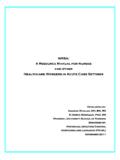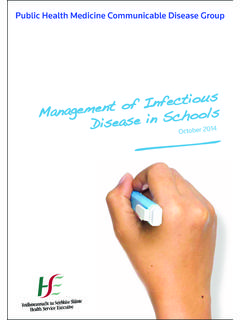Transcription of MRSA and VRE: What is the concern - MedicEd.com
1 mrsa and vre : what is the concern ? 1 CEUs By: Dr. Michelle Duffelmeyer Objectives By the end of this lecture, the participant should be able to . 1. Define nosocomial infection. 2. List how nosocomial infections can be prevented. 3. Understand why we should prevent nosocomial infections from spreading and when to institute transmission based isolation precautions. 4. Describe MRSA as methicillin-resistant S. aureus and VRE as vancomycin-resistant enterococci and what this means for the patient and the health care provider. The sign over the patient's bed reads: MRSA. VRE. what is it? Why should we care? what does it mean for the patient? what does it mean for me? Introduction The emerging drug resistance of S. aureus (staphylococcus aureus) is a story foretold. Since 1942, the year penicillin G was introduced, resistant strains of S.
2 Aureus have emerged. Newer semisynthetic penicillins, such as beta lactamase resistant drugs, emerged since that time but S. aureus was only temporarily halted. To recognize the potential impact of this, consider that the resistance of MRSA to the antibiotic vancomycin threatens to return us to the morbidity and mortality seen by S. aureus in the pre-antibiotic era. References: 1. F. A. Waldvogel. (February 1999). New resistance in staphylococcus aureus. New England Journal of Medicine, 340, (7). pp 556-557. Nosocomial vs community acquired Before we continue with the conquering story of S. aureus let us briefly review some definitions. o A community-acquired infection is one that an otherwise healthy person obtains while not confined to any institution or hospital. o A nosocomial infection arises in a person who is hospitalized or living in an institution such as a nursing home.
3 So a nosocomial infection is a hospital-acquired infection or institution acquired infection. Staphylococcus Aureus what is S. aureus? Staphylococcus aureus (S. aureus) or staph is a gram-positive cocci bacillus. A. bacterium. It occurs naturally on humans and in the environment. S. aureus is notorious for causing skin infections pimples, boils, furuncles, styes, infant impetigo. S. Aureus is responsible for many severe infections in the immunocompromised, chronically ill, and burn patients. S. Aureus can cause pneumonia, abscess, osteomyelitis (bone infections), acute endocarditis (infection of heart valves), mastitis (breast infections) and meningitis. S. aureus can release a toxin, which causes a form of food poisoning. Scalded skin syndrome in infants and children is caused by S. aureus. Toxic shock syndrome (TSS) reported in young menstruating women was found to be caused by an exotoxin produced by S.
4 Aureus. References: 1. Baron, S. (ed) 1991. Medical microbiology. Churchill Livingstone, Inc. pp. 203-214 chapter 12. staphylococcus Jay Cohen 2. Lawy, (August 20, 1998). Medical Progress: Staphylococcus aureus infections. NEJ Med, 339, (8) pp 520-532. Emerging Resistance You can see from above that S. aureus is a formidable opponent. It is a common cause of nosocomial and community-acquired infections. As described above, penicillin was the first drug proven successful in battling S. aureus in the 1940s. Resistance soon emerged and newer generations of penicillins, including methicillin, were developed that worked well in treating penicillin-resistant S. aureus. However, MRSA (methicillin-resistant S. aureus) has developed. This leaves vancomycin as our prime drug for this strain of bacteria. 1996 marked the world's first documented case of clinical infection due to MRSA with resistance to vancomycin (a glycopeptide antibiotic).
5 Treatment is difficult for this strain of bacteria. There have since been 4 more cases in the United States. The true concern is that development of a strain of MRSA with full resistance to vancomycin leaves us with little or no treatment for a life threatening infection. References: 1. Smith, et al. (February 18, 1999). Emergence of vancomycin resistance in staphylococcus aureus. New England Journal of Medicine 340, (7) pp 493-501. 2. Sierodzki, K., Roberts, et al. (February 18, 1999). Brief Report: The development of vancomycin resistance in a patient with methicillin-resistance staphylococcus aureus infection. New England Journal of Medicine, 340(7) pp 517-523. Key Points S. Aureus. Staphylococcus aureus or staph is a bacterium commonly found on the skin and in the nose. It can cause minor infections like pimples or boils, or major life threatening infections.
6 MRSA. This is S. aureus that has become resistant to methicillin and other commonly used antibiotics. Vancomycin is the most effective antibiotic for this strain of S. aureus. VISA. S. Aureus bacteria that is intermediately sensitive to vancomycin (Vancomycin- intermediate S. aureus). VRSA. S. aureus bacteria that is resistant to vancomycin (vancomycin-resistant S. aureus). This bacteria has not yet been found. If this emerges vancomycin would not be effective at all. References: 1. VISA Vancomycin-Intermediate Staphylococcus aureus Fact Sheet. CDC Centers for Disease Control. Reviewed January 7, 2000, accessed December 28, 2001. Which patients are likely to have MRSA? Humans are the natural reservoir of S. aureus. As much as 50% of all healthy people are colonized with S. aureus. Rates of staph colonization are higher in the chronically ill, people with AIDS (acquired immunodeficiency syndrome), IV drug users and diabetics.
7 This population is also likely to be colonized or infected with MRSA. Those patients with MRSA who are frequently hospitalized undergo dialysis and have prolonged treatment with vancomycin are likely to develop MRSA with intermediate resistance to vancomycin (VISA). References: 1. Lawy, (August 20, 1998). Medical Progress: Staphylococcus aureus infections. New England Journal of Medicine, 339, (8) pp 520-532. 2. Smith, et al. (February 18, 1999). Emergence of vancomycin resistance in staphylococcus aureus. New England Journal of Medicine 340, (7) pp 493-501. what does this mean for the patient? S. aureus causes a wide range of infections from minor skin infections to life threatening respiratory, bone, joint and heart infections. Patients can be simply colonized with MRSA or actively infected with the organism.
8 Once infected the drug of choice is vancomycin. If the patient is unable to tolerate vancomycin there are other choices, but none as effective as vancomycin. If a patient is infected with S. aureus resistant to methicillin and also only intermediately sensitive to vancomycin the treatment is difficult and requires help from your infectious disease physician and infection control of the hospital. what does MRSA mean to the health care provider? Can you become infected with MRSA from a patient? Yes. Can you get symptoms from MRSA? Yes, you can get skin infections, such as boils. Can I then transmit MRSA to my family members? Yes. There was a case report in the Journal of American Medical Association in 1999 where a twenty-seven year old mother transmitted MRSA to several of her children. Her newborn had cutaneous pustular lesion and her older child a buttock abscess.
9 References: 1. L'Heriteau F et al. (September 15, 1999). Community-acquired methicillin-resistant Staphylococcus aureus and familial transmission. JAMA, 282, (11). pp. 1038-9. what should you do when you care for a patient with MRSA? Wear gloves. They do not need to be sterile but new gloves need to be put on for each patient so you do not transmit MRSA from one patient to another. Wash your hands. This is a vital link in preventing the spread of MRSA. Use disposable stethoscopes provided by the hospital or swab the entire stethoscope with alcohol. There have been cases of external otitis (outer ear infection) with MRSA when the earpiece of the stethoscopes was not also cleaned. Strict use of non-sterile gowns. Masks may be indicated if the patient has a respiratory form of MRSA such as MRSA. pneumonia.
10 If transporting a patient from the hospital or nursing home, you need to check with those caring for the patient regarding any additional precautions. But when in doubt, a mask is reasonable precaution that is readily available to you. Check your local region or state for protocols when dealing with MRSA patients. References: 1. J. G. Bartlett, et al. (May 3, 1999). A Roundtable Discussion of Antibiotic Resistance: Putting the Lessons to Work. The American Journal of Medicine, 106, (5A). Discussion 48S-52S. VRE-Vancomycin Resistant Enterococcus Enterococcus is a bacteria in the streptococcus family. It usually infects the urinary and biliary tract. It is not thought of as a highly virulent organism, however, new emergence of resistant organisms have complicated this picture. VRE was first identified in the mid-1980's.








